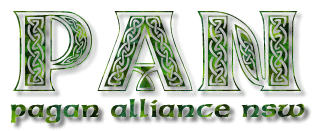|
Ostara 1999 Newsletter Meaning of the Sabbat |

|
Ostara, or the Spring Equinox, occurs each year between the 21st and 23rd September. The equinox is where there are equal hours of light and dark. After the Winter Solstice, when the sun was born anew, to the time at Imbolc when we welcomed back the light, now to Ostara when the light will start to consume the dark. There will be lengthening days, and decreasing dark times until the sun reaches his zenith as the Midsummer Solstice.
It is not that our days will start to get warmer. Our bones will start to thaw and the heart of the earth will pump the vital lifeblood into the plants of the earth to encourage them to bloom.
The Spring Equinox is a time for new beginnings. A time to spring clean the house and the mind. It is a time for purification and rededication. A ritual to mark this time may include: waking up early on Equinox morn and thoroughly spring cleaning the house. When the physical cleaning is done, it is time to turn inwards. Have a shower, or bath, and cleanse yourself. Perhaps your alter or sacred space could do with a spruce up? This is a time to clear your mind and focus on new beginnings.
Ostara is a time to rededicate yourself to your path, it is a time to reflect on the seeds that were sown at Yule.
The Goddess is the Spring Maiden who walks with the young God who was born at Yule. She is her most fertile, her most creative. She inspires new growth and life.
The egg is a very traditional Ostara symbol. As the egg represents potential from a developing incubation, it is a symbol of fertility and reproduction, as well as a symbol of potential new life.
For children, an egg hunt could be just the thing to shake free the bonds of winter. The brightly painted eggs are reprsentative of the new blooms and flowers we see all around.
Lying out under the new sun, and walking with the Maiden, is a time to be young, a time to grow and a time to be free. It is a time to be open minded and see the possibilities of a fertile summer. Look up to the clouds, what do you see?
With a hey, and a ho, and a hey nonino,
That o'er the green cornfield did pass,
In the Spring time, the only pretty ring time,
When the birds do sing, hey a dong, ding:
Sweet lovers love the spring.
(As You Like It, Shakespeare. Act 5, Scene III.)
![]()
The Spring
Thomas Carew (1695 - 1640)
Now that the winter's gone, the earth hath lost
Her snow-white robes, and now no more the frost
Candies the grass, or casts an icy cream
Upon the silver lake or crystal stream;
But the warm sun thaws the benumbed earth,
And makes it tender; gives a sacred birth
To the dead swallow; wakes in hollow tree
The drowsy cuckoo, and the humble-bee.
Now do a choir of chirping minstrels bring
In triumph to the world the youthful Spring.
The valleys, hills, and woods in rich array
Welcome the coming of the long'd-for May.
Now hath the scalding noonday sun the power
To melt that marble ice, which still doth hold
Her heart congeal'd, and makes her pity cold.
The ox, which lately did for shelter fly
Into the stall, doth now securely lie
In open fields; and love no more is made
By the fireside, but in the cooler shade
Amyntas now doth with his Chloris sleep
Under a sycamore, and all things keep
Time with the season; only she soth carry
June in her eyes, in her heart January
![]()